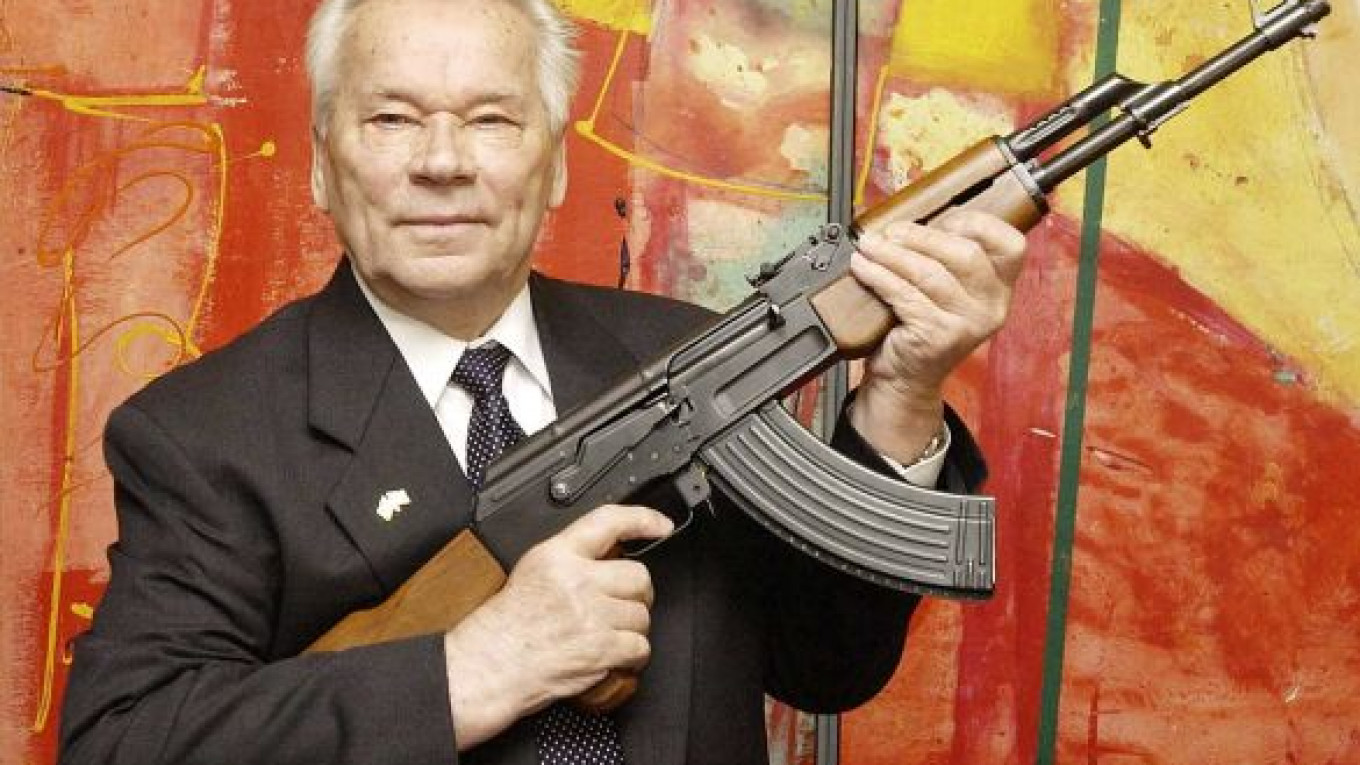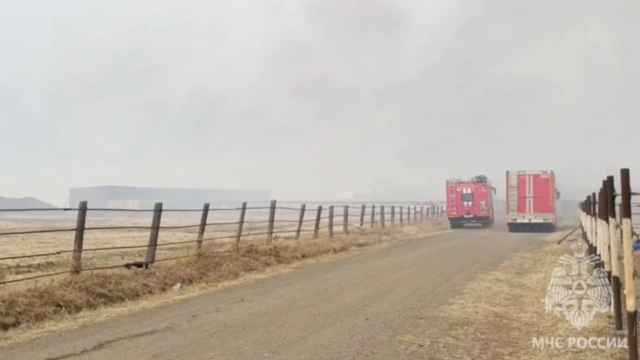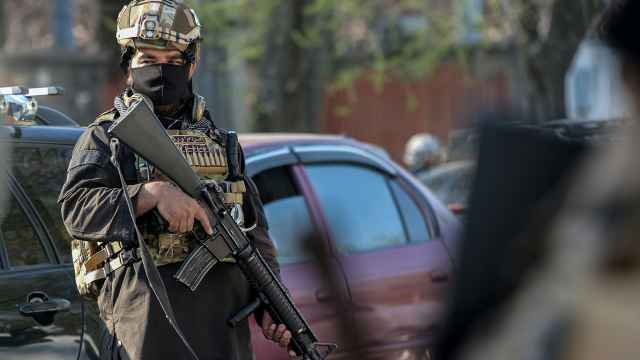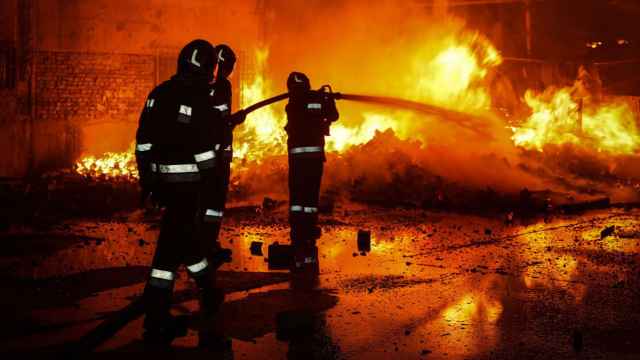Mikhail Kalashnikov, the designer of the AK-47, the world's most famous assault rifle, died in Izhevsk, Udmurtia, on Monday at the age of 94.
A statement released by the press service of Udmurtia's top official did not disclose the exact cause of death, but said it came after "a long and painful illness," Interfax reported.
Vladimir Muzlov, the health minister of Udmurtia, said the cause of death would be determined after an autopsy, which would have to be approved by Kalashnikov's immediate family first.
Denis Loginov, deputy head of the chief administration of Udmurtia, said burial preparations would be handled by the republic.
Kalashnikov's health had been declining throughout the year since he was first hospitalized in May. The Associated Press reported at the time that he was being treated at a cardiology clinic.
In June, he had an operation in Moscow to have a pacemaker implanted.
For the remainder of the year, he was in and out of the hospital, though he was said to be recuperating in September after spending time at a health retreat.
Kalashnikov became a national icon and acquired worldwide fame for creating the AK-47, which is believed by some analysts to be superior to Western equivalents.
He was born in 1919 in the Altai region to a peasant couple. In 1930, most of his family was deprived of their property and deported to the Tomsk region during Josef Stalin's repressions.
In his youth, Kalashnikov combined an interest in technology with a penchant for poetry; he wrote many poems during his life.
His career as a designer started when he served in the Red Army during World War II. While in hospital, he overheard fellow soldiers complaining about current rifle models and set his mind on creating a better weapon.
"Blame the Nazi Germans for making me become a gun designer," he said, as cited by the Associated Press in 2007. "I always wanted to construct agriculture machinery."
In 1947, he designed the AK-47 model, and since 1949, Kalashnikov weapons have held undisputed sway as standard issue assault rifles in Russia. Kalashnikov had lived and worked at the Izhmash arms factory in Izhevsk since that time, and his son Viktor followed in his footsteps, also becoming an arms designer.
There is, however, a controversial theory that the legendary rifle was actually created by Nazi Germany's most prolific small arms inventor, Hugo Schmeisser, while the credit was given to Kalashnikov. Schmeisser was caught by Soviet troops in 1945 and relocated to Izhmash as a forced laborer.
Other fringe theories attribute the weapon's creation to Russian designers A. Bulkin and Sergei Simonov, and Czech designer Vaclav Holek.
The AK-47 has frequently been praised for its qualities, though opinions differ on whether it surpasses foreign equivalents.
In terms of reliability and interchangeability, the AK-47 model "is held as better than Western assault rifles," though it has some limitations, including insufficient accuracy in some cases, Colby Howard, an associate researcher at Russia's Center for Analysis of Strategies and Technologies, said by phone.
"Kalashnikov will be known as one of the greatest technological innovators of the last century," he added.
Igor Korotchenko, head of the Center for Analysis of World Arms Trade and editor-in-chief of the National Defense magazine, said by phone that Western assault rifles were more capricious than Kalashnikovs.
"The AK-47 was a very successful weapon for an army based on mass mobilization — cheap to produce and easy to use," he said.
But one of Kalashnikov rifles' weaknesses is that they did not provide for upgrades or tuning until recently, though currently this defect is being eliminated, Korotchenko said.
Kalashnikov designed about 150 models of small arms, including the AK-47 and AKM assault rifles, the RPK machine gun and the Saiga semi-automatic rifle.
Weapons designed by Kalashnikov conquered the global market. According to a World Bank estimate, out of the 500 million total firearms available worldwide, 100 million come from the Kalashnikov family, and 75 million are AK-47s.
Many Kalashnikov rifles are sold illegally without an official license and smuggled to various governments, rebel groups, criminals and civilians. Izhmash, also known as the Kalashnikov Concern — the official manufacturer of Kalashnikov rifles in Russia — patented the weapon only in 1997, and it accounts for just a small share of the world's AK-47 output.
Due to its worldwide fame, the Kalashnikov brand has become a bone of contention.
The inventor said in 2009 that he was motivated purely by service to his country and had no profit from weapons production. But he owned 30 percent of German company Marken Marketing International, which produces vodka, umbrellas, knives and other products under the Kalashnikov name.
The company, which is run by Kalashnikov's grandson Igor Krasnovsky, has been involved in a dispute with Izhmash over rights to the brand. In August, Izhmash seemed to attempt to capitalize on the brand's popularity by renaming itself the Kalashnikov Concern.
The German firm apparently allowed Kalashnikov to make a decent living.
Nikolai Shklyayev, a long-time friend of Kalashnikov, told the Sobesednik newspaper last year that the inventor did not have any financial problems but had repeatedly refused to retire from Izhmash despite his old age because he enjoyed working.
"For him, work is life," he said at the time. "Every time he was offered to retire … he took offense."
Shklyayev went on to say that the designer had a firm, "iron" character.
Two American nuclear reduction treaty inspectors who worked in Votkinsk, Udmurtia, also shared their impressions of Kalashnikov with The Moscow Times. The Izhmash factory would allow the inventor to drive one of their VIP vehicles, a Saab sedan, to the site for his visits with the Americans from the late 1980s.
Douglas Englund, a former deputy director of the U.S. Defense Threat Reduction Agency, found him "friendly and engaging."
Another inspector — George Connell, former head of the U.S. inspection facility in Votkinsk — said Kalashnikov was into American products.
"All I remember is that he liked American ice cream — a lot," he said.
Justin Lifflander contributed to this report.
Contact the author at o.sukhov@imedia.ru
A Message from The Moscow Times:
Dear readers,
We are facing unprecedented challenges. Russia's Prosecutor General's Office has designated The Moscow Times as an "undesirable" organization, criminalizing our work and putting our staff at risk of prosecution. This follows our earlier unjust labeling as a "foreign agent."
These actions are direct attempts to silence independent journalism in Russia. The authorities claim our work "discredits the decisions of the Russian leadership." We see things differently: we strive to provide accurate, unbiased reporting on Russia.
We, the journalists of The Moscow Times, refuse to be silenced. But to continue our work, we need your help.
Your support, no matter how small, makes a world of difference. If you can, please support us monthly starting from just $2. It's quick to set up, and every contribution makes a significant impact.
By supporting The Moscow Times, you're defending open, independent journalism in the face of repression. Thank you for standing with us.
Remind me later.






